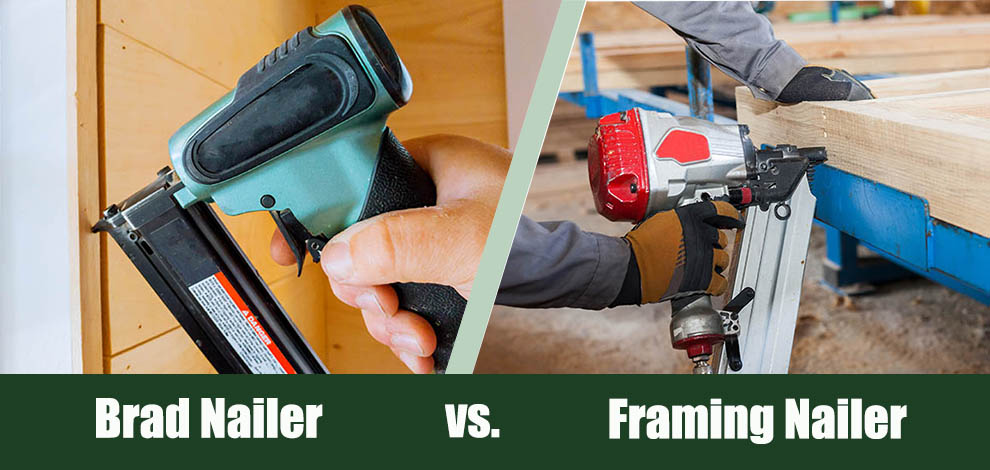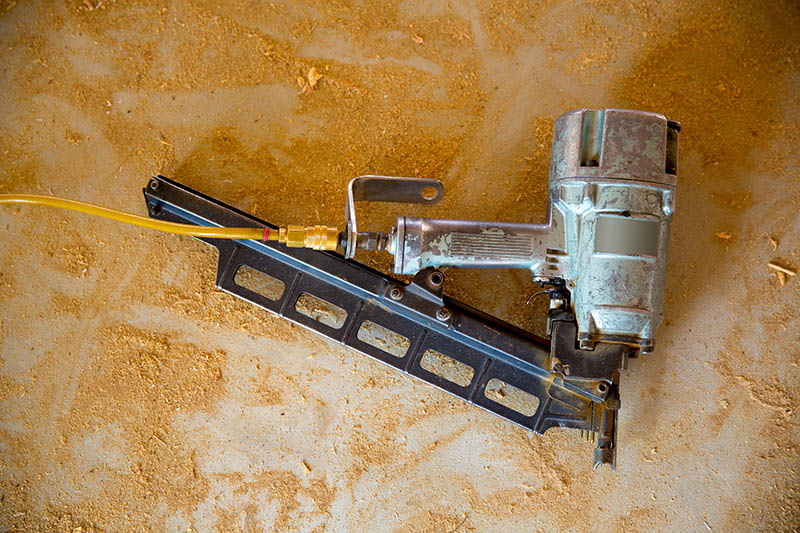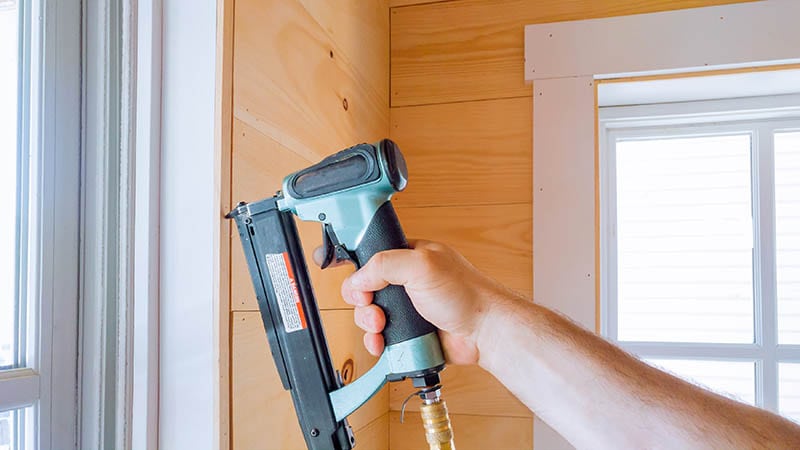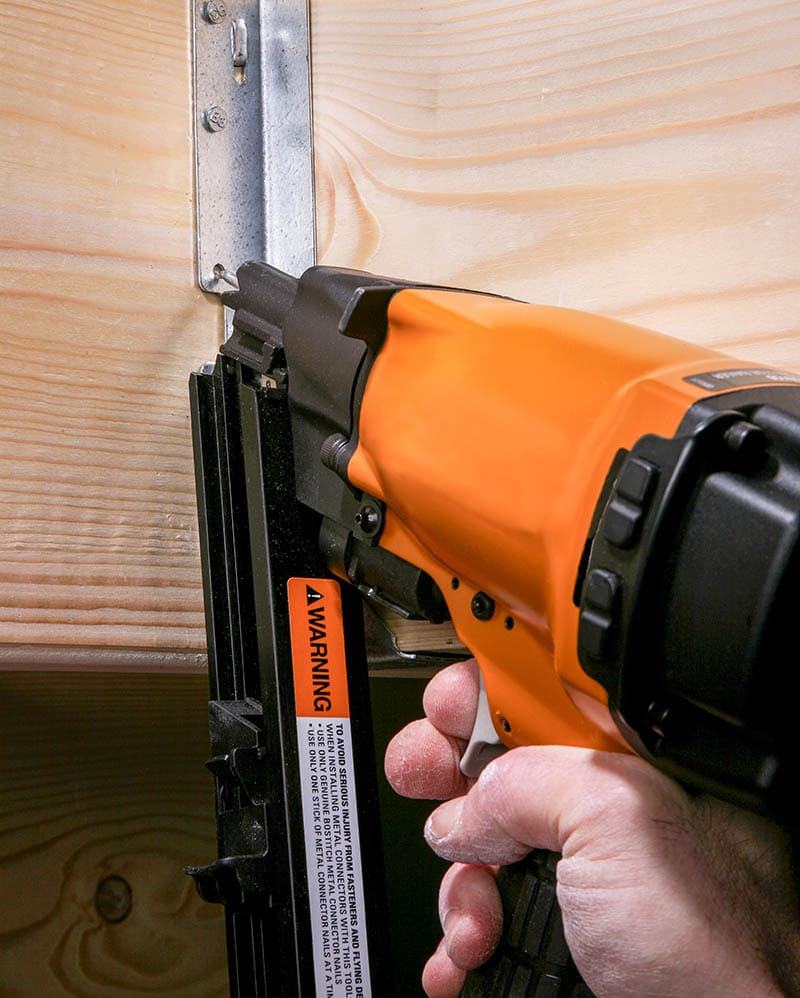Brad Nailer vs Framing Nailer: Pros, Cons, & Differences
-
Pete Ortiz
- Last updated:

Gone are the days when you needed a hammer to complete every home improvement task. With nailers or nail guns, driving nails is as easy as squeezing a trigger. But with so many different kinds of nailers out there, it can be tricky to know which one is best for the job at hand.
Brad nailers and framing nailers are among the most popular types of nailers available today. Although you can use both to drive nails, they have distinct differences that make each better suited for different tasks.
Here’s what you need to know about brad nailers and framing nailers, including their main differences and each of their pros and cons. That way, you can choose the right nailer for your next project.
At a Glance
- Compact & lightweight
- Best for light-duty work
- Low power for penetrating softwood
- Thin 18-nail gauge
- 1/2 inch to 2 inches nail length
- T-shaped nail heads
- Bigger & heavier
- Ideal for heavy-duty work
- High power for penetrating tougher materials
- Larger 4 to 11 gauge sized nails
- 1-1/4 inches to 3-1/2 inches nail length
- Full round or clipped head
 Overview of Brad Nailers
Overview of Brad Nailers

Brad nailers are small, lightweight tools that use brad nails to secure materials together. They’re ideal for lighter jobs like trim work and decorative framing.
Brad nailers have a long magazine that contains brad nails ranging in size from 3/4 inch to 2 1/2 inch. When you pull the trigger, the brad nailer drives the brad nails through the material—usually without leaving any holes.
How Do Brad Nailers Work?
A brad nailer consists of a sliding piston, which drives a long blade. The compressor in the nailer increases pressure above the piston head, forcing it to move downward. Pressing the triggers creates this pressure differential that pushes the brad nails out of the magazine and into the material.
The brad nails then expand slightly to keep them securely in place. This makes brad nailers ideal for lightweight tasks requiring extra holding power without having to drill a hole into the material.
When you use brad nailers to secure two pieces of material together, the brad nails leave tiny, virtually invisible holes. These nails penetrate only a short distance into the material, making them an excellent alternative to glue. However, they only provide moderate holding power and are ideal for projects requiring lower levels of strength and durability.
Unfortunately, brad nails are unsuitable for use on materials like MDF and some types of plywood. Because they don’t penetrate deeply enough, they won’t provide the desired stability. Other types of nailers would be better when crafting furniture for holding up heavy items.
What Is a Brad Nailer Good For?
Brad nailers are small and lightweight. They make the perfect tool for light-duty projects like craft work or making decorative trims, fine woodworking, or holding pieces together for gluing. These tools work well on delicate materials like softwood and veneers. Furthermore, their size ensures you can easily maneuver around tight corners or in hard-to-reach areas.
- Compact and lightweight
- Easy to maneuver around tight corners
- Excellent choice for precision work
- Creates a light stronghold with virtually invisible holes
- Only ideal for light-duty work
- Unsuitable for use on some materials
Overview of Framing Nailers

Framing nailers, also known as clip guns or stick nailers, are much bigger than brad nailers and use larger nails for heavier duties like framing a house. They’re usually battery-operated and feature a metal magazine with framing nails ranging from 1 to 3 1/2 inches.
The force of the firing pin is stronger than brad nailers, so it can penetrate tougher materials with more power. Framing nailers also typically have adjustable depth settings, which allow you to customize the penetration of the nail into the material.
How Do Framing Nailers Work?
Framing nailers have a similar mechanism to brad nailers, but they use a much stronger force that’s powerful enough to penetrate tougher materials like wood and drywall. Unlike the brad nailer, this tool also works on MDF and some types of plywood. That’s because it has a stronger force that penetrates these materials with ease.
The firing pin is pushed upward by an electric motor, which then pushes the nail out of the magazine and into the material. Then, it uses an adjustable depth setting to ensure the nail is driven in at the right penetration level.
Once the nail is pushed all the way in, a reset collar at the bottom of the firing pin moves up to prevent any further firing until you reset the nailer. Generally, this tool provides higher holding power, making it ideal for easily securing heavy materials.
The amount of power delivered by framing nailers makes them unsuitable for woodworking beginners. Without the right skills, you risk injuring yourself. Also, you must properly adjust the tool to avoid splitting wood due to the powerful force of the firing pin.
What Is a Framing Nailer Good For?
Framing nailers are designed for heavy-duty projects. They are essential tools for any home building or construction project and are powerful enough to penetrate the toughest materials and secure them in place.
Furthermore, framing nailers come with different types of nail heads, such as round heads, clipped heads, and offset heads. This gives you the flexibility to choose the nail head that best fits even the toughest projects.
- Ideal for use on tough materials
- Higher holding power
- Excellent for heavy-duty projects
- A range of nail head options
- Not beginner friendly
- Powerful force can split wood
 What Are the Major Differences Between Brad and Framing Nailers?
What Are the Major Differences Between Brad and Framing Nailers?
Clearly, brad and framing nailers offer different features that make them more suitable for certain applications. Here’s a quick comparison of the main differences between brad and framing nailers.
Size and Weight
Brad nailers are much smaller and lighter than framing nailers, making them easier to handle and less fatiguing. Framing nailers, on the other hand, are larger and heavier due to the powerful motor that’s needed for the higher penetration force.
Nail Size and Type
Brad nailers use brad nails which range from 1/2 inch to 1 3/8 inches in length. Framing nailers use larger nails ranging from 1 inch to 3 1/2 inches and have different types of heads, such as round heads, clipped heads, and offset heads.

Precision and Accuracy
Brad nailers have an adjustable depth setting that allows for greater precision and accuracy when nailing. On the other hand, framing nailers require a bit of practice to get the depth settings right as it’s easy to overdrive or split wood if not handled with care.
Driving Force
Brad nailers generate less force than framing nailers, making them ideal for brad-only work. Framing nailers, on the other hand, use a more powerful force, which makes them suitable for heavy-duty jobs, such as framing and construction.
When to Use a Brad Nailer
Brad nailers are best used on lighter materials like moldings, trim, and cabinetry. They’re also ideal for DIY projects that don’t require a large amount of force. You can also use brad nailers to secure plywood and other materials.
As mentioned above, brad nails are a great substitute for glue. This makes brad nailers an excellent choice when you don’t want to mess around with messy adhesive for carpentry or architectural concepts.
When to Use a Framing Nailer
Framing nailers are best used on heavier materials like lumber and drywall. They’re also great for home building and construction projects that require a high level of force.
However, it’s important to note that framing nailers require additional accessories like air compressors and hoses in order to function properly. They’re also slightly dangerous and mostly suitable for experienced users who know how to properly adjust the depth settings.

Factors to Consider When Buying a Brad Nailer or Framing Nailer
There are a plethora of brad and framing nailers available on the market. Here are a couple of factors to consider to help you make the right choice.
Power Source
The power source is one of the most important considerations when buying brad or framing nailers. Brad nailers typically use either cordless battery-powered motors or pneumatic motors that require an air compressor. Framing nailers usually use pneumatic motors as they require a large amount of force to penetrate tough materials.
Nail Size and Type
The size of brad nails typically ranges from 1/2 inch to 1 3/8 inches. Framing nailers, however, use larger nails that range from 1 inch to 3 1/2 inches and have different types of heads depending on the application.
The Stick-Style and Coil-Style for Framing Nailers
Most framing nailers come in two types: stick-style and coil-style. Stick-style nailers are lighter and more comfortable to use for extended periods of time, while coil-style nailers can hold larger quantities of nails but are heavier and less comfortable.
The Price
Price is an important factor to consider when buying brad or framing nailers. Generally, brad nailers are cheaper than framing nailers as they require less force and accessories.
Don’t buy the cheapest nailer you can find, as it may not have the features or power you need for your project. Do your research, read reviews, and compare prices to get the best brad nailer or framing nailer for your budget.
Conclusion
Brad nailers and framing nailers have distinct differences that should be understood before making a purchase. Brad nailers are great for lighter materials, precision tasks, and DIY projects, while framing nailers are better suited for heavier materials, construction jobs, and larger applications.
By understanding these differences, as well as the various power sources, nail sizes, types, and prices of brad and framing nailers, you’ll be able to make an informed decision when selecting the right tool for your project. With a bit of research and knowledge, you can choose the brad or framing nailer that best fits your needs.
Featured Image Credit: (L) hutch photography, Shutterstock | (R) brizmaker, Shutterstock
Contents



 What Are the Major Differences Between Brad and Framing Nailers?
What Are the Major Differences Between Brad and Framing Nailers?
